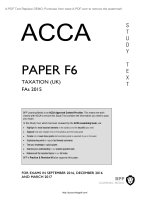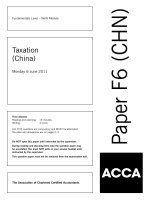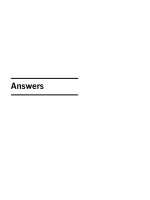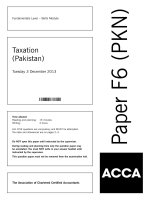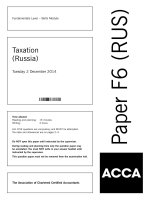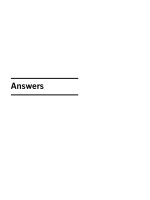BPP ACCA f6 taxation (FA 2015) book 2017
Bạn đang xem bản rút gọn của tài liệu. Xem và tải ngay bản đầy đủ của tài liệu tại đây (5.39 MB, 511 trang )
A-PDF Text Replace DEMO: Purchase from www.A-PDF.com to remove the watermark
S
T
U
D
Y
PAPER F6
TAXATION (UK)
FAs 2015
BPP Learning Media is an ACCA Approved Content Provider. This means we work
closely with ACCA to ensure this Study Text contains the information you need to pass
your exam.
In this Study Text, which has been reviewed by the ACCA examining team, we:
Highlight the most important elements in the syllabus and the key skills you need
Signpost how each chapter links to the syllabus and the study guide
Provide lots of exam focus points demonstrating what is expected of you in the exam
Emphasise key points in regular fast forward summaries
Test your knowledge in quick quizzes
Examine your understanding in our practice question bank
Reference all the important topics in our full index
BPP's Practice & Revision Kit also supports this paper.
FOR EXAMS IN SEPTEMBER 2016, DECEMBER 2016
AND MARCH 2017
/>
T
E
X
T
First edition 2007
Ninth edition January 2016
A note about copyright
Dear Customer
ISBN 9781 4727 4423 4
(Previous ISBN 9781 4727 2239 3)
eISBN 9781 4727 4665 8
What does the little © mean and why does it matter?
British Library Cataloguing-in-Publication Data
A catalogue record for this book is available from the
British Library
Published by
Your market-leading BPP books, course materials and e-learning
materials do not write and update themselves. People write them on
their own behalf or as employees of an organisation that invests in
this activity. Copyright law protects their livelihoods. It does so by
creating rights over the use of the content.
Breach of copyright is a form of theft – as well as being a criminal
offence in some jurisdictions, it is potentially a serious breach of
professional ethics.
BPP Learning Media Ltd
BPP House, Aldine Place
142–144 Uxbridge Road
London W12 8AA
With current technology, things might seem a bit hazy but, basically,
without the express permission of BPP Learning Media:
www.bpp.com/learningmedia
Photocopying our materials is a breach of copyright
Scanning, ripcasting or conversion of our digital materials
into different file formats, uploading them to facebook or emailing them to your friends is a breach of copyright
Printed in the United Kingdom by
You can, of course, sell your books, in the form in which you have
bought them – once you have finished with them. (Is this fair to your
fellow students? We update for a reason.) Please note the e-products
are sold on a single user licence basis: we do not supply 'unlock'
codes to people who have bought them secondhand.
RICOH UK Limited
Unit 2
Wells Place
Merstham
RH1 3LG
Your learning materials, published by BPP Learning
Media Ltd, are printed on paper obtained from traceable
sustainable sources.
And what about outside the UK? BPP Learning Media strives to make
our materials available at prices students can afford by local printing
arrangements, pricing policies and partnerships which are clearly
listed on our website. A tiny minority ignore this and indulge in
criminal activity by illegally photocopying our material or supporting
organisations that do. If they act illegally and unethically in one area,
can you really trust them?
All rights reserved. No part of this publication may be reproduced,
stored in a retrieval system or transmitted, in any form or by any
means, electronic, mechanical, photocopying, recording or
otherwise, without the prior written permission of BPP Learning
Media Ltd.
We are grateful to the Association of Chartered Certified
Accountants for permission to reproduce past examination
questions. The suggested solutions in the practice answer bank
have been prepared by BPP Learning Media Ltd, unless otherwise
stated.
©
BPP Learning Media Ltd
2016
ii
/>
Contents
Page
Introduction
Helping you to pass
Studying F6
The exam paper
Syllabus and study guide
v
vii
viii
ix
Part A UK tax system
1
Introduction to the UK tax system
3
Part B Income tax and national insurance contributions
2
3
4
5
6
7
8
9
10
11
12
Computing taxable income and the income tax liability
Employment income
Taxable and exempt benefits. The PAYE system
Pensions
Property income
Computing trading income
Capital allowances
Assessable trading income
Trading losses
Partnerships and limited liability partnerships
National insurance contributions
17
43
55
77
87
97
115
135
147
163
173
Part C Chargeable gains for individuals
13
14
15
16
Computing chargeable gains
Chattels and the principal private residence exemption
Business reliefs
Shares and securities
185
197
209
221
Part D Tax administration for individuals
17
Self assessment and payment of tax by individuals
233
Part E Inheritance tax
18
Inheritance tax: scope and transfers of value
253
Part F Corporation tax
19
20
21
22
23
Computing taxable total profits and the corporation tax liability
Chargeable gains for companies
Losses
Groups
Self assessment and payment of tax by companies
279
295
307
319
329
Part G Value added tax
24
25
An introduction to VAT
Further aspects of VAT
343
365
iii
/>
Practice question and answer bank
Tax tables
Index
Review form
iv
/>
379
477
483
Helping you to pass
BPP Learning Media – ACCA Approved Content Provider
As ACCA's Approved Content Provider, BPP Learning Media gives you the opportunity to use study
materials reviewed by the ACCA examination team. By incorporating the examination team's comments
and suggestions regarding the depth and breadth of syllabus coverage, the BPP Learning Media Study
Text provides excellent, ACCA-approved support for your studies.
The PER alert!
Before you can qualify as an ACCA member, you not only have to pass all your exams but also fulfil a three
year practical experience requirement (PER). To help you to recognise areas of the syllabus that you
might be able to apply in the workplace to achieve different performance objectives, we have introduced
the 'PER alert' feature. You will find this feature throughout the Study Text to remind you that what you
are learning to pass your ACCA exams is equally useful to the fulfilment of the PER requirement.
Your achievement of the PER should now be recorded in your online My Experience record.
Tackling studying
Studying can be a daunting prospect, particularly when you have lots of other commitments. The different
features of the Study Text, the purposes of which are explained fully on the Chapter features page, will
help you whilst studying and improve your chances of exam success.
Developing exam awareness
Our Texts are completely focused on helping you pass your exam.
Our advice on Studying F6 outlines the content of the paper and the necessary skills you are expected to
be able to demonstrate and any brought forward knowledge you are expected to have.
Exam focus points are included within the chapters to highlight when and how specific topics were
examined, or how they might be examined in the future.
Using the Syllabus and Study Guide
You can find the syllabus and study guide on pages ix – xxvi of this Study Text.
Testing what you can do
Testing yourself helps you develop the skills you need to pass the exam and also confirms that you can
recall what you have learnt.
We include Questions – lots of them – both within chapters and in the Practice Question Bank, as well as
Quick Quizzes at the end of each chapter to test your knowledge of the chapter content.
Introduction
/>
v
Chapter features
Each chapter contains a number of helpful features to guide you through each topic.
Topic list
Topic list
Syllabus reference
Tells you what you will be studying in this chapter and the
relevant section numbers, together with ACCA syllabus
references.
Introduction
Puts the chapter content in the context of the syllabus as
a whole.
Study Guide
Links the chapter content with ACCA guidance.
Exam Guide
Highlights how examinable the chapter content is likely to
be and the ways in which it could be examined.
Summarises the content of main chapter headings,
allowing you to preview and review each section easily.
FAST FORWARD
Examples
Demonstrate how to apply key knowledge and
techniques.
Key terms
Definitions of important concepts that can often earn you
easy marks in exams.
Exam focus points
Tell you when and how specific topics were examined, or
how they may be examined in the future.
Formula to learn
Formulae that are not given in the exam but which have to
be learnt.
Gives you a useful indication of syllabus areas that
closely relate to performance objectives in your Practical
Experience Requirement (PER).
Gives you essential practice of techniques covered in the
chapter.
Question
vi
vi
Chapter Roundup
A full list of the Fast Forwards included in the chapter,
providing an easy source of review.
Quick Quiz
A quick test of your knowledge of the main topics in the
chapter.
Practice Question Bank
Found at the back of the Study Text with more
comprehensive chapter questions. Cross referenced for
easy navigation.
Introduction
/>
Studying F6
As the name suggests, this paper examines the basic principles of taxation. This is a very important area
for certified accountants as many areas of practice involve a consideration of taxation issues. It also
provides a foundation for P6: Advanced Taxation which will be chosen by those who work in a tax
environment.
Members of the F6 examination team have written several technical articles including two on Inheritance
Tax, two on chargeable gains, one on groups, two on VAT, one on benefits, one on motor cars, one on
adjustment of profit and one on Finance Acts 2015. All these articles are available on the ACCA website.
Make sure you read them to gain further insight into what the F6 examination team is looking for.
1 What F6 is about
You are introduced to the rationale behind – and the functions of – the tax system. The syllabus then
considers the separate taxes that an accountant would need to have a detailed knowledge of, such as
income tax from self-employment, employment and investments, the corporation tax liability of
individual companies and groups of companies, the national insurance contribution liabilities of both
employed and self employed persons, the value added tax liability of businesses, the chargeable gains
arising on disposals of investments by both individuals and companies, and the inheritance tax liabilities
arising on chargeable lifetime transfers and on death.
You will be expected to have a detailed knowledge of these taxes, but no previous knowledge is
assumed. You should study the basics carefully and learn the pro forma computations. It then becomes
straightforward to complete these by slotting in figures from your detailed workings.
As well as being able to calculate tax liabilities, you may be required to explain the basis of the
calculations, apply tax planning techniques for individuals and companies and identify the compliance
issues for each major tax through a variety of business and personal scenarios and situations.
2 What skills are required?
Be able to integrate knowledge and understanding from across the syllabus to enable you to
complete detailed computations of tax liabilities.
Be able to explain the underlying principles of taxation by providing a simple summary of the rules
and how they apply to the particular situation.
Be able to apply tax planning techniques by identifying available options and testing them to see
which has the greater effect on tax liabilities.
3 How to improve your chances of passing
There is no choice in this paper, all questions have to be answered. You must therefore study the
entire syllabus, there are no short-cuts.
The first section of the paper consists of 15 objective test questions, each worth two marks each.
These will inevitably cover a wide range of the syllabus.
Practising questions under timed conditions is essential. BPP's Practice & Revision Kit contains
10 mark and 15 mark questions on all areas of the syllabus.
Answer all parts of the question. Even if you cannot do all of the calculation elements, you will still
be able to gain marks in the discussion parts.
Answer selectively – the examination team will expect you to consider carefully what is relevant
and significant enough to include in your answer. Don't include unnecessary information.
Keep an eye out for articles as the examination team will use Student Accountant to communicate
with students.
Introduction
/>
vii
The exam paper
Format of the paper
From September 2016, the exam will be 3 hours and 15 minutes in duration. The exam paper is divided
into three sections.
Section A consists of 15 objective test questions of two marks each.
Section B consists of 15 mini scenario based objective test questions of two marks each.
Section C consists of one constructive response question of 10 marks and two constructive response
questions of 15 marks. In Section C, answers to the questions will require a mixture of calculations and
discussion.
The paper will be predominantly computational and all questions are compulsory.
The two 15 mark questions will focus on income tax (syllabus area B) and corporation tax (syllabus area
E). All other questions can cover any areas of the syllabus.
Computer Based Examination
ACCA have announced that they intend to commence the launch of computer based exams (CBEs) for F5–
F9 towards the end of 2016. At the time of going to print the exact details had not been confirmed. Paper
based examinations will be run in parallel while the CBEs are phased in and BPP materials have been
designed to support you, whichever exam option you choose.
viii
viii
Introduction
/>
Syllabus and Study Guide
The F6 syllabus and study guide can be found below.
Introduction
/>
ix
x
x
Introduction
/>
Introduction
/>
xi
xii
xii
Introduction
/>
Introduction
/>
xiii
xiv
xiv
Introduction
/>
Introduction
/>
xv
xvi
xvi
Introduction
/>
Introduction
/>
xvii
xviii
xviii
Introduction
/>
Introduction
/>
xix
xx
xx
Introduction
/>
Introduction
/>
xxi
xxii
xxii
Introduction
/>
Introduction
/>
xxiii
xxiv
xxiv
Introduction
/>
Introduction
/>
xxv


